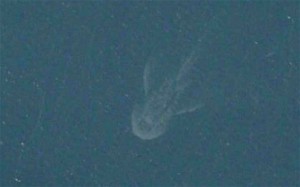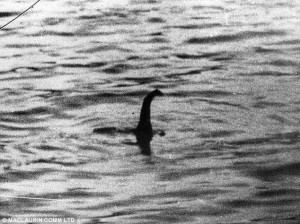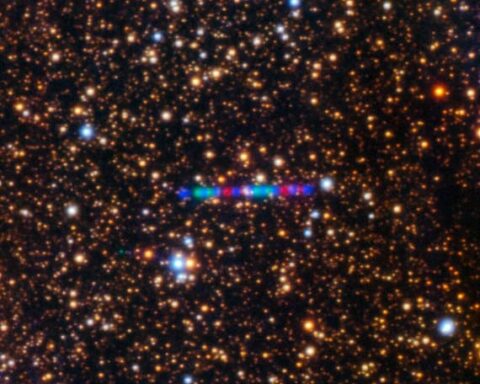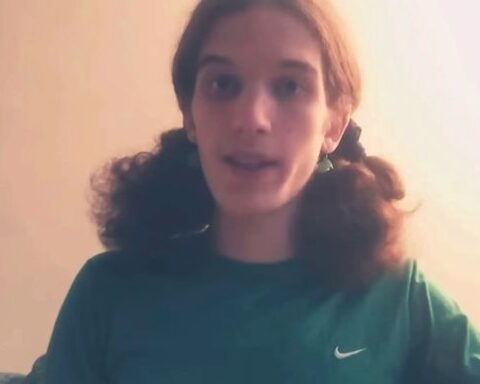The recent Apple Maps picture of an unidentified object in Scotland’s most famous waters (picture below) has sparked fresh chatter about the possible existence of the legendary Loch Ness monster.
The image, taken by an Apple map satellite, depicts a shadowy form of around 100 feet in length with something comparable to flippers in the water of Loch Ness.
While it doesn’t even begin to answer the question of whether ‘Nessie’ actually exists, it at least serves to revive the debate somewhat; or at least it does for a few weeks, then everyone will forget about it again.
Having been interested in the paranormal in general for a long time, the Loch Ness monster myth, and for that matter the broader subject of myths themselves as generation-spanning cultural phenomena (Loch Ness, Bigfoot, the Yeti, Roswell, etc), has always interested me.
It is possible I’ve always been less interested in whether a myth has any absolute truth to it or not and more interested in the nature of the mythology itself; in other words, I guess, in the nature of myth as entertainment and as part of culture.

Whether Nessie is real or isn’t (I’m guessing the latter), the mythology itself has been around so long that it having any basis in fact no longer seems to even matter. Like the Roswell Incident in 1947 or even Jesus rising on the third day, the mythology is by now so established that even decisive evidence against it wouldn’t mean the end of the cultural phenomenon.
The most common speculation among Nessie believers has traditionally been that the ‘creature’ represents a line of long-surviving plesiosaurs. It’s fascinating to note that, although most people think the Nessie myth originates in the 1930s, particularly with the famous ‘Surgeon’s Photo’, the earliest regarded reference to a monster in regard to the Loch Ness area is from the 7th century, in a work lionizing the Irish saint, Life of St. Columba, with reference to a terrifying “water beast”.
The text, typical of overwrought religious writings, has the Saint encounter the water monster himself but he scares it away with the sign of the cross and the incident is celebrated as a miracle.
Modern interest in the monster can probably be said to have begun with the 1933 George Spicer sighting, when Mr Spicer and his wife saw ‘a most extraordinary form of animal’ crossing the road in front of their car. Their description of the bizarre creature was of a large body and long, narrow neck, slightly thicker than an elephant’s trunk and as long as the width of the road. The same year a motorcyclist named Arthur Grant claimed to have nearly hit the creature at about 1 a.m. on a moonlit evening. Grant claimed he saw a small head attached to a long neck and that the creature saw him and crossed the road back into the loch.

A veterinary expert, he described it as a hybrid between a seal and a plesiosaur. Meanwhile in November the same year a Hugh Gray claimed to have seen a large creature rising up from the lake; he took several pictures, only one of which showed up in the developed photos. Critics have rejected the photograph, suggesting it’s a blurred image of a dog, but some researchers have given credence to the photograph, citing an ‘eel-like’ head to one side of the main image.
The famous “Surgeon’s Photograph” taken in the following year is purported to be the first photo of a “head and neck” and is the most famous Loch Ness Monster image; however, it has since been notoriously confessed to have been a hoax. Sporadic land sightings continued until 1963, when film of the creature was shot in the loch. However, the distance of approximately 4 kilometres from which the footage was shot resulted in footage of poor quality, impossible to regard as decisive.
In 1954 a strange sonar contact was made by the fishing boat Rival III. The vessel’s crew observed sonar readings of a large object keeping pace with the boat at a depth of approximately 480 ft. This wasn’t the only alleged sonar incident involving an unknown object in the area.
In more recent years, the highly publicised George Edwards photo from 2012, which the skipper claimed to be “the most convincing Nessie photograph ever” has been largely refuted by researchers, particularly given Mr Edwards past forgeries. Edwards spends an alleged sixty hours a week on the loch with his boat, which is named Nessie Hunter IV.
Among other more minor incidents, there have also been the Taylor, Holmes and Dinsdade films (1938, 2007 and 1968, respectively).
But, hey, we’re here to talk about Magick Rituals, Demonic Entities and the Aleister Crowley Connection…
The most fascinating, and bizarre, thing I’ve ever heard about the Loch Ness Monster was a theory I came across in a book about ten years ago that the ‘monster’ had been ‘created’ by the infamous black magician Aleister Crowley; the idea being not that he created a physical beast at all but some kind of apparition-like creature that haunts the loch the same way a human ghost might haunt an old theatre or house.
Famously dubbed “the wickedest man in the world” and (some say erroneously) regarded as a Satanist, Crowley has remained a highly influential figure in Western esotericism and ‘black magic’ and is still regarded as a prophet in various new-age circles. Crowley stands as the most influential or iconic figure in modern occultism: and the idea that he was performing occult or magical rituals at Loch Ness (at Boleskine House, where he lived for a time) isn’t far-fetched, given his self-documented history of such rituals and such attempts at communication with occult beings, interdimensional or ‘demonic’ entities and the like.
A thoroughly unpleasant man, however there’s no denying the “Great Beast” Crowley’s enduring status as a counter-culture and black-arts icon; not just counter-culture for that matter, but referenced over the years by entities as mainstream as The Beatles, David Bowie and Michael Jackson. In fact, Led Zeppelin‘s Jimmy Page (a massive occultist and Crowley disciple) was so obsessed with Crowley that he acquired Boleskine House for himself for a time.
For better or worse (probably worse), there’s probably no one in the last hundred years who has acquired so much of the aura or following of a modern prophet as Crowley has.
As the myth (or the myth within the myth) has it, Crowley “created” the Loch Ness monster when he failed to properly complete an elaborate ‘Magick’ ritual at Boleskine House, on the south-east shore of Loch Ness; his failure said to have unleashed “a demonic entity”.
Crowley had acquired Boleskine House in order to carry out a series of rituals aimed at a specific supernatural communion, which was nothing all too out-of-the-ordinary for him, but he specifically chose that location, believing it to have magical properties conducive to his experiments.
The area of Loch Ness itself has a long history of claims of strange phenomena and incidents including UFOs, MiB encounters, alleged witnesses to shape-shifting incidents, demonic encounters, ghosts and fairies, much of it pre-dating the modern sightings of the ‘monster’ that have made it famous. Across from Boleskine House is a graveyard with a reputation for strange activity and which was established long before Crowley arrived at the location and was linked with stories of witchcraft.
The estate has also been burnt down a number of times; including – according to the legends – centuries ago when it was first built and a fire killed numerous churchgoers there.
Interestingly, at the site of what is arguably the world’s most famous monster, Crowley’s actions (said to have included black masses and wild orgies; which, again, would’ve been nothing out-of-the-ordinary for him) were said to have led to some other disturbing phenomena earlier than the Nessie sightings. In his autobiography, Crowley described how the spirits he “summoned” at Loch Ness got wildly out of hand, resulting in one housemaid leaving and a workman going insane.
Crowley also insinuated that he was indirectly responsible for a local butcher accidentally severing an artery and bleeding to death.
It is clear Crowley considered this Boleskine House to be a “Thelemic Kiblah” (to use his own esoteric language): a kind of occult focal point for mystical energies, making it a potent Mecca for the performing of magical rituals.
Aside from that, it’s worth nothing that many parapsychologists posit the theory that water itself is a very powerful medium, a very powerful conductor/amplifier of spectral activity or incidents.
Further information on the origins of the Crowley/Loch-Ness myth can be found in Aleister Crowley and the Other Loch Ness Monster – a short documentary by Garry S. Grant (and narrated by Jesus of Nazareth; wait, I’ll rephrase – narrated by the actor Robert Powell, who portrayed Jesus in the classic 70s television mini-drama).
For someone who predicted a century of ‘Crowley-anity’ would follow his death, perhaps Crowley is not as influential as he would’ve liked; having said that, a BBC poll just over a decade ago ranked him as the seventy-third greatest Briton of all time, which isn’t such bad going for someone often considered a madman (or, at the very least, something of a monster).
Whether the infamous Crowley had anything to do with the ‘monster’ or not, this myth is almost as interesting, perhaps more so, than the Loch Ness Monster myth itself.
However, both myths – be they intertwined or kept separate – will doubtless fascinate many minds for a long time to come.





Thanks for the input; the design/layout is something I might think about a little more as you suggest.